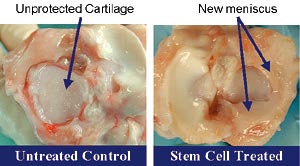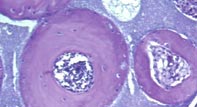Stem cell applications slowly emerging in orthopedics
One tool to harness the power of stem cells for musculoskeletal repair is available and others could follow in a year or two.
In 1989, John F. Connolly, MD, first described a process by which progenitor cells derived from bone marrow could be concentrated intraoperatively with a centrifuge and then used to enhance bone repair. He reported good results, but because the process was considered expensive and time intensive, it was not widely adopted.
Over the last few years, however, several methods have been developed that allow orthopedic surgeons to use stem cells more easily to treat damaged bone, cartilage and menisci. The Cellect Technology from DePuy Biologics allows surgeons to aspirate autologous bone marrow from the iliac crest and concentrate the progenitor cells using a disposable device and a specially designed implantable matrix.
Osiris Therapeutics Inc. has an application before the Food and Drug Administration to start clinical studies on a product that features allogenic stem cells injected into the knee to stimulate meniscal regeneration. In addition, researchers in Italy have reported the use of autologous bone marrow stromal cells to repair large bone defects.
The time it took for these tools to be developed can be explained by the many challenges that researchers faced, said Arnold Caplan, PhD. Almost 15 years ago Caplan, director of the Skeletal Research Center at Case Western Reserve University in Cleveland, and his colleagues developed a method for isolating stem cells from bone marrow.
“When we first started this project, I thought that getting enough of the cells was going to be the rate-limiting step. Then all we would have to do would be to pop them into the right site and we’d get regeneration.
“Of course that was hugely naive. The problem is getting the right number of cells in the right place in the right way at the right time. It’s a logistical nightmare. So we’ve taken a huge step back and have started a basic science approach to learn how to target cells to very precise locations,” Caplan told Orthopedics Today.
Many hurdles
|
||
Researchers have faced a variety of other hurdles. George F. Muschler, MD, an orthopedic surgeon who developed the technology on which Cellect is based, said a “huge challenge” has been that stem cells are rare in the tissue of adult patients, especially when the patient is in poor health.
“There’s also the problem of biologic variation between patients and between tissue sites because what we design as an optimal strategy for one location is not likely to be the optimal strategy for another location,” said Muschler, who is director of the Bone Biology Laboratory at the Cleveland Clinic.
Scott P. Bruder, MD, PhD, vice president of DePuy Biologics, has done extensive research on stem cells over the last decade, including work with Caplan and Osiris Therapeutics. He believes the challenges are both scientific and commercial.
“On the technical side, how do you ensure that the cells behave as we want them to when we put them in place? If you take a stem cell and put it in a tendon site because you want to form tendon, how do you ensure that it doesn’t form bone? That’s the major technical challenge,” Bruder told Orthopedics Today.
“The commercialization challenge is to prepare cell-based implants so that they are affordable, easy for the surgeon to use and manufactured with strict control over quality from sample to sample. The industry would need to convince physicians, payers and the FDA that these implants are going to perform as reproducibly as a prosthetic hip or knee.”
Selective retention
|
||
Despite those difficulties, however, there are tools on the market that are effective or ones in the pipeline that appear to work well. Cellect, for example, uses what DePuy calls “selective retention” to concentrate stem cells from bone marrow. The surgeon aspirates several syringes of bone marrow from the patient’s iliac crest and adds them to a vacuum-controlled vessel containing specially designed matrix materials like Healos Bone Graft Substitute, Conduit Tri-Calcium Phosphate Granules or mineralized cancellous bone chips and demineralized cortical fibers.
The bone marrow is then automatically filtered through the matrix several times. The matrix is highly porous and has a high surface area for cell attachment, so more than 90% of the osteogenic stem cells are retained, while virtually all of the red blood cells and 60% to 80% of the white blood cells pass through, Muschler said.
“The result is that we can concentrate the progenitors back up to the range where we would normally find them in local tissues and then transplant them in an environment where they’re not competing with quite so many cells.”
Bruder said the concentrated stem cells show accelerated healing compared to autograft in several investigations. “We see this used as an autograft substitute, not in conjunction with autograft, so it is a true and total replacement for bone.” Bruder added that animal studies comparing Cellect with simple autologous bone marrow delivered on a matrix showed that Cellect resulted in “faster and more robust” bone formation.
Muschler has used Cellect in about 50 patients who had nonunions, compromised tissue beds or compromised systemic biology, and has had a 90% success rate in treating established long-bone nonunions.
Isadore Lieberman, MD, of the Cleveland Clinic, is conducting a pilot study on using Cellect for spinal fusions. Both Muschler and Lieberman will have two-year data later this year, and there are a number of other multicenter clinical trials underway in long bone and spine models. DePuy also has an application before the FDA for a cell-based technology for cartilage repair and expects to begin clinical trials later this year, Bruder said.
Meniscal regeneration
Osiris also expects to begin clinical trials to evaluate the use of Chondrogen, a preparation of injectable allogenic stem cells suspended in hyaluronan, for meniscal regeneration. The company has completed required animal and safety trials and is awaiting the FDA’s response, said C. Randal Mills, PhD, president and chief executive officer. The company is also developing a method for using stem cells in bone regeneration that Mills said is a “very, very powerful osteogenic material.”
Mills believes there are several reasons why Osiris is in an advantageous position to develop medical applications for stem cells: Their cells are adult-derived, so they are able to avoid the controversy over using embryonic stem cells; they are able to take one donor’s stem cells and grow them in culture to yield several thousand doses; their preparations are easy to use, usually only requiring an injection; they can be frozen for years and are easily stored; and they are universally compatible.
“Our cells don’t need to be matched; anyone can contribute to anyone. There is no immune response or rejection so there’s no need for immune suppression,” Mills said.
Another company investigating stem cells for musculoskeletal medicine is Genzyme, the developer of Carticel, the autologous cultured chondrocytes for cartilage repair. Genzyme is working to develop ways to use allogenic and autologous stem cells for cartilage and meniscal repair, said Ross Tubo, PhD, the company’s vice president of orthopedic research and stem cell biology. Research is now at the animal stage, and it will likely be another few years before the company enters clinical trials, he said.
Research continuing
Other researchers who have had success in harnessing the power of stem cells have taken a step back to do more basic science work. In 2001, the New England Journal of Medicine published a letter from Ranieri Cancedda, MD, describing what he believes were the first patients ever treated with a polyceramic loaded with autologous bone marrow stromal cells for large bone defects.
|
||
The three patients are now five years out and have had excellent results, said Cancedda, dean of biotechnology at the University of Genoa and chair of innovative therapies at the Cancer Institute at Genoa.
Cancedda told Orthopedics Today that the hydroxyapatite scaffold used in the three patients had a porosity of about 60%, which was the standard at that time. While the scaffold was effective because it promoted bone growth, it was not resorbable and still remains in the patients. Another problem is that the density of the scaffold interfered with radiographic follow up to assess bone formation.
Cancedda and his colleagues have been investigating a number of newer scaffolds that are engineered to resorb more quickly. They have used animal models to investigate the repair of 4-cm defects in the mid-diaphysis of the tibia and are now running a major clinical trial in collaboration with the AO.
“We already have data from a sheep study that we are preparing for publication where we are able to show that within two years, the scaffold has completely resorbed and only bone has formed. This, I think, is a major advance in the field and we are waiting to complete this large preclinical trial with all the results to move this into the clinic.”
In the United States, Caplan is working with colleagues to develop a model for ligament and tendon repair. “The ligament and tendon are real nightmares because these are tissues that are hugely loaded and if you have impaired loading, you won’t get normal regeneration of those tissues.”
They are searching for a natural tissue that will integrate into the tendon or ligament and allow the stem cells to differentiate along the proper pathway. Caplan said they began identifying the optimal delivery scaffold.
“The proof of concept that these cells can be used in a variety of situations is, I think, available, but the development of the delivery vehicles and the surgical techniques to use them is still in the developmental phase,” he said.
Arnold Caplan and Randy Mills have financial interests in a product mentioned in this article. Mills and Scott Bruder are paid consultants for two different companies mentioned in this article.



